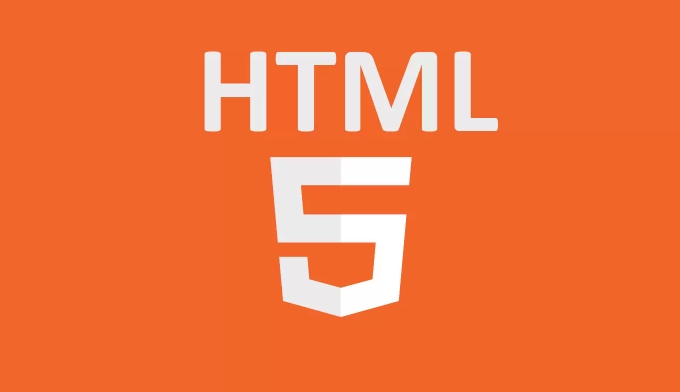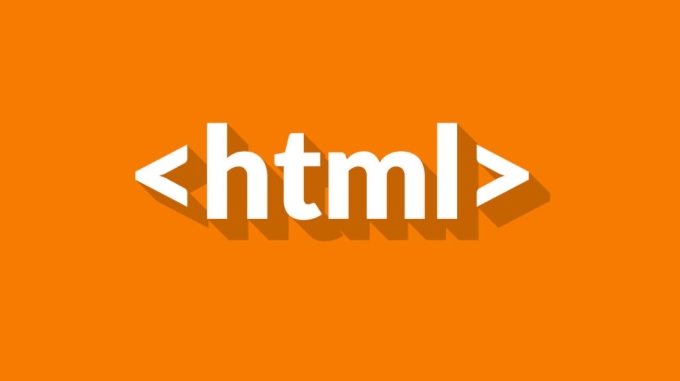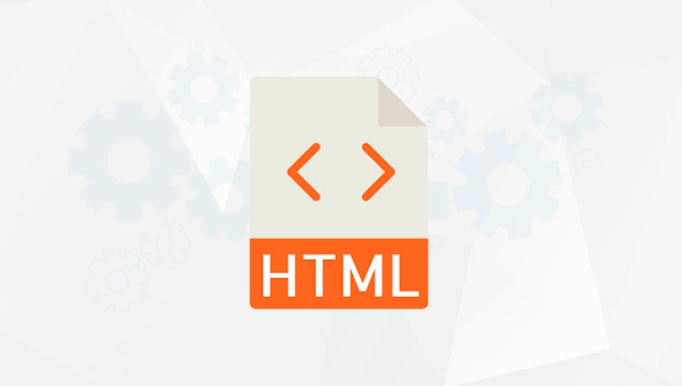您如何使用HTML5语义元素正确构建文档?
使用HTML5语义化标签能提升可访问性、SEO和代码可读性;2. 正确使用<header>、<nav>、<main>、<article>、<section>、<aside>和<footer>等标签定义页面结构;3. 避免滥用<div>和<section>,确保<main>唯一性,<article>用于独立内容,<aside>用于相关辅助内容;4. 标题应遵循<h1>到<h6>的逻辑层级,通常每页一个<h1>,并用<section>或<article>包裹主题相关内容;5. 语义化结构应像文档大纲一样清晰、有序且具有层次性,从而帮助浏览器和开发者准确理解页面内容。

Properly structuring a document with HTML5 semantic elements means using tags that clearly describe their meaning to both the browser and the developer. Instead of relying solely on generic divs, semantic elements improve accessibility, SEO, and code readability. Here’s how to structure a typical web page correctly.

Use the Right Structural Elements
Start with the basic HTML5 document structure and layer in semantic tags that define the purpose of each section:
<!DOCTYPE html>
<html lang="en">
<head>
<meta charset="UTF-8">
<title>Page Title</title>
<meta name="viewport" content="width=device-width, initial-scale=1.0">
</head>
<body>
<header>
<h1>Website Title</h1>
<nav>
<ul>
<li><a href="#home">Home</a></li>
<li><a href="#about">About</a></li>
<li><a href="#contact">Contact</a></li>
</ul>
</nav>
</header>
<main>
<article>
<h2>Article Title</h2>
<p>This is a self-contained piece of content, like a blog post or news article.</p>
</article>
<aside>
<p>Related content, ads, or side notes go here.</p>
</aside>
</main>
<section>
<h2>Additional Content Section</h2>
<p>This could be a grouping of related content, like features or testimonials.</p>
</section>
<footer>
<p>© 2024 Your Company. All rights reserved.</p>
</footer>
</body>
</html>Understand the Purpose of Key Semantic Tags
Each semantic element has a specific role. Using them correctly helps screen readers and search engines interpret your content.

<header>: Contains introductory content or navigation links. Typically includes the site logo, title, and main navigation.<nav>: Defines a block of navigation links. Use it for primary menus, but not for every group of links.<main>: Wraps the main content of the page. There should be only one<main>per page.<article>: Represents a self-contained composition, such as a blog post, comment, or news story.<section>: Groups thematically related content, usually with a heading. Think of it as a chapter in a book.<aside>: Contains content tangentially related to the surrounding content, like sidebars or pull quotes.<footer>: Contains information about its section, such as author, copyright, or related links.
Avoid Common Mistakes
Even with semantic elements, it’s easy to misuse them. Watch out for these pitfalls:
- Don’t use
<section>or<div>when<article>fits better — if the content makes sense on its own (like in an RSS feed), use<article>. - Don’t overuse
<div>— replace generic containers with semantic alternatives when possible. - Don’t put multiple
<main>elements on one page — it should be unique. - Don’t use
<header>or<footer>only for styling — they carry structural meaning. - Avoid using
<aside>for content unrelated to the context — it should still have some relevance.
Also, remember that headings (<h1> to <h6>) should reflect the document outline. Use them in a logical order, even if CSS handles visual sizing.

Nesting and Document Outline
While HTML5 introduced a more sophisticated document outline algorithm based on sections and headings, most browsers and assistive technologies still rely heavily on heading levels. So, it's safest to:
- Use one
<h1>per page (usually in<main>or<article>) - Maintain a logical hierarchy:
<h1>→<h2>→<h3>, etc. - Wrap related headings and content in
<section>or<article>to reinforce structure
For example:
<main>
<article>
<h1>How to Structure HTML5 Documents</h1>
<section>
<h2>Understanding Semantic Elements</h2>
<p>Explanation goes here.</p>
</section>
<section>
<h2>Best Practices</h2>
<p>Tips and guidelines.</p>
</section>
</article>
</main>Basically, structure your HTML like an outline: clear, meaningful, and hierarchical. Semantic elements make that easier — when used correctly.
以上是您如何使用HTML5语义元素正确构建文档?的详细内容。更多信息请关注PHP中文网其他相关文章!

热AI工具

Undress AI Tool
免费脱衣服图片

Undresser.AI Undress
人工智能驱动的应用程序,用于创建逼真的裸体照片

AI Clothes Remover
用于从照片中去除衣服的在线人工智能工具。

Clothoff.io
AI脱衣机

Video Face Swap
使用我们完全免费的人工智能换脸工具轻松在任何视频中换脸!

热门文章

热工具

记事本++7.3.1
好用且免费的代码编辑器

SublimeText3汉化版
中文版,非常好用

禅工作室 13.0.1
功能强大的PHP集成开发环境

Dreamweaver CS6
视觉化网页开发工具

SublimeText3 Mac版
神级代码编辑软件(SublimeText3)
 为什么我的图像未显示在HTML中?
Jul 28, 2025 am 02:08 AM
为什么我的图像未显示在HTML中?
Jul 28, 2025 am 02:08 AM
图像未显示通常因文件路径错误、文件名或扩展名不正确、HTML语法问题或浏览器缓存导致。1.确保src路径与文件实际位置一致,使用正确的相对路径;2.检查文件名大小写及扩展名是否完全匹配,并通过直接输入URL验证图片能否加载;3.核对img标签语法是否正确,确保无多余字符且alt属性值恰当;4.尝试强制刷新页面、清除缓存或使用隐身模式排除缓存干扰。按此顺序排查可解决大多数HTML图片显示问题。
 带有Astro的无头CMS和静态站点生成(SSG)
Jul 26, 2025 am 07:31 AM
带有Astro的无头CMS和静态站点生成(SSG)
Jul 26, 2025 am 07:31 AM
使用无头CMS与Astro的静态站点生成(SSG)结合,可构建高性能、内容驱动的网站。2.Astro在构建时通过API从无头CMS(如Sanity、Contentful、Strapi、WordPress或DatoCMS)获取内容并预渲染为静态页面。3.使用getStaticPaths()生成页面路径,通过CMSAPI调用获取数据,实现内容与前端分离。4.优势包括卓越性能(快速加载、利于SEO)、友好编辑体验、架构灵活性、高安全性及可扩展性。5.内容更新需重新构建站点,可通过CMSwebhook触
 如何在HTML5中使用无线电按钮?
Jul 21, 2025 am 01:08 AM
如何在HTML5中使用无线电按钮?
Jul 21, 2025 am 01:08 AM
在HTML5中使用单选按钮的关键在于理解其工作原理并正确组织代码结构。1.每个radio按钮的name属性必须相同,以实现互斥选择;2.使用label标签提升可访问性和点击体验;3.推荐将每个选项包裹在div或label中以增强结构清晰度和样式控制;4.通过checked属性设置默认选中项;5.value值应简洁有意义,便于表单提交处理;6.可通过CSS自定义样式,但需确保功能正常。掌握这些要点能有效避免常见问题并提升使用效果。
 HTML5中是否仍在使用标签?
Jul 21, 2025 am 02:47 AM
HTML5中是否仍在使用标签?
Jul 21, 2025 am 02:47 AM
是的,是HTML5的一部分,但其使用已逐渐减少且存在争议。用于将主标题与副标题组合在一起,使文档大纲中仅识别最高级别的标题;例如,主标题和副标题可被包裹在中,以表明仅为辅助标题而非独立章节标题;然而,其不再广泛使用的原因包括:1.浏览器和屏幕阅读器对其支持不一致,2.存在更简单的替代方案如使用CSS控制样式,3.HTML文档大纲算法未被广泛支持;尽管如此,在语义要求较高的网站或文档中仍可考虑使用;而大多数情况下,开发者倾向使用单一、通过CSS管理样式并保持清晰的标题层级。
 语义HTML对于SEO和可访问性的重要性
Jul 30, 2025 am 05:05 AM
语义HTML对于SEO和可访问性的重要性
Jul 30, 2025 am 05:05 AM
semantichtmlimprovesbothseoandAccessibility formaningfultagSthatConveyContentsUrture.1)ItenhancesseothRoughBetterContterContenterContenterContenchyArchyWithProperHeadingLeheadinglevels,ifravedIndexingViaeLementLikeAnd,andsupportFortForrichSnippersingsundsustructussunddbuestussund.2)
 H5网络信息API用于自适应加载
Jul 23, 2025 am 04:15 AM
H5网络信息API用于自适应加载
Jul 23, 2025 am 04:15 AM
H5的NetworkInformationAPI可通过判断网络类型优化加载策略。①使用navigator.connection可获取网络类型及在线状态;②根据effectiveType值(如slow-2g、4g、5g)决定加载高清资源或轻量内容;③通过监听change事件动态调整加载策略;④需注意兼容性、iOS支持有限及隐私模式限制等问题。
 使用html5 schema.org标记定义自定义词汇。
Jul 31, 2025 am 10:50 AM
使用html5 schema.org标记定义自定义词汇。
Jul 31, 2025 am 10:50 AM
Schema.org标记是通过语义标签(如itemscope、itemtype、itemprop)帮助搜索引擎理解网页内容的结构化数据格式;其可用于定义自定义词汇表,方法包括扩展已有类型或使用additionalType引入新类型;实际应用中应保持结构清晰、优先使用官方属性、测试代码有效性、确保自定义类型可访问;注意事项包括接受部分支持、避免拼写错误、选择合适格式如JSON-LD。
 HTML5解析器如何处理错误?
Aug 02, 2025 am 07:51 AM
HTML5解析器如何处理错误?
Aug 02, 2025 am 07:51 AM
HTML5parsershandlemalformedHTMLbyfollowingadeterministicalgorithmtoensureconsistentandrobustrendering.1.Formismatchedorunclosedtags,theparserautomaticallyclosestagsandadjustsnestingbasedoncontext,suchasclosingabeforeaandreopeningitafterward.2.Withimp







